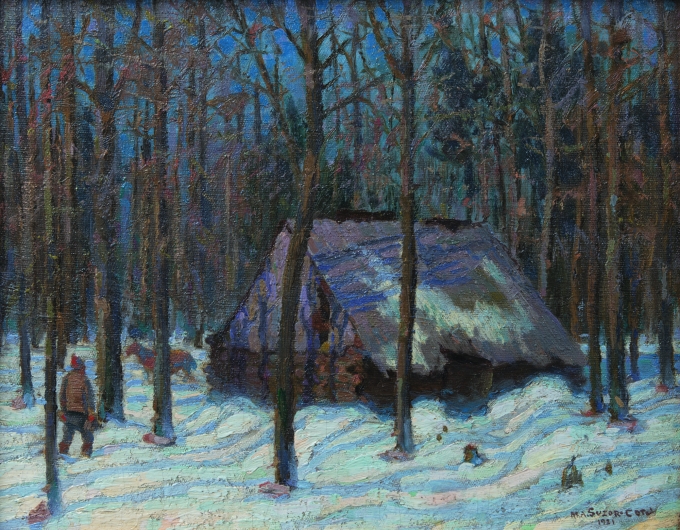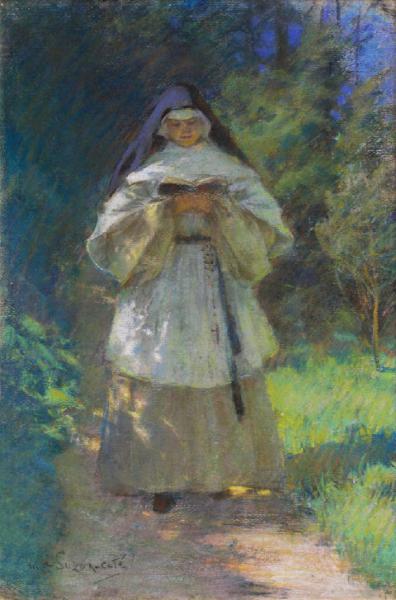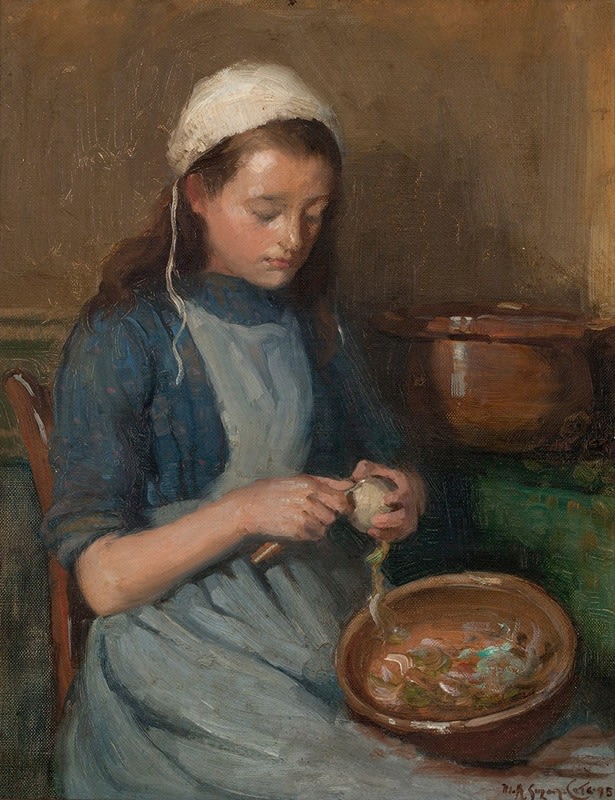Marc-Aurèle Suzor-Coté was born in 1869 in Arthabaska, Quebec, to Théophile Coté, a notary, and Marie-Céline-Adéline Suzor, whose family immigrated to Canada from Foy, France. He grew up with five brothers and two sisters, in a household that encouraged his art. From an early age, Suzor-Coté showed remarkable artistic talent. While studying at the Collège des Frères du Sacré-Cœur in Arthabaska, he was mentored by Brother Clépotien, who introduced him to drawing and colour theory. His early works, including a pencil portrait of his father, revealed his extraordinary skill and earned him top prizes in calligraphy, composition, and music. At the age of 13, he painted his first landscape. As a young boy, he trained under artist Joseph-Thomas Rousseau, and the two intricately decorated several churches in his home town Arthabaska and surrounding areas.

Cabane à sucre, oil on canvas by Marc-Aurèle de Foy Suzor-Coté
In 1887, Suzor-Coté left Arthabaska for Montreal, where he trained under Father Joseph Chabert and collaborated on church decoration projects with Maxime Rousseau, painting cherubs and religious scenes. He also completed frescoes for Wilfrid Laurier, who was a family friend, and in 1890 painted Saint Peter Repentant at the Hôtel-Dieu in Montreal.

Encouraged by his friend Joseph Saint-Charles and drawn to impressionism, Suzor-Coté made his first trip to Paris in 1891 to further his training. He studied at the École des Beaux-Arts under Léon Bonnat and attended the Académie Julian and Académie Colarossi, also receiving advice from Henri Harpignies. He became friends with the Canadian artist Maurice Cullen in 1892 at the Beaux-Arts. While in France, he produced sketches of the French countryside, traveled through Belgium, Brittany, and Normandy, and focused on landscapes and peasant life, avoiding urban scenes except for Montreal later in his career. He was influenced by the realism of Gustave Courbet and the idealism of Jean-Baptiste-Camille Corot. In 1894, he exhibited at the Salon des Champs-Élysées a painting based on sketches from Normandy, depicting an elderly woman knitting by her home’s fireplace.

Suzor-Coté returned to Canada in 1895, to Arthabaska. His work by then reflected his exposure to Impressionism, which informed his distinctive handling of light, colour, and atmosphere. He became known for landscapes, nudes, and scenes of everyday life in Quebec, often depicting rural settings around Arthabaska. He completed many historical Canadian paintings, such as Jacques Cartier meets the Indians at Stadacona in 1535, which is now in the Musée national des beaux-arts du Québec.

Throughout his career, Suzor-Coté exhibited widely, including a notable 1901 exhibition at the Scott and Son Gallery in Montreal and a 1910 exhibition in Toronto. In 1907, he moved to Montreal. He benefited from the mentorship and support of prominent figures such as William Brymner, director of the Art Association of Montreal. Over his lifetime, he produced more than 1,500 works encompassing landscapes, nudes, historical scenes, and portraits. On December 4, 1929, La Presse described him as “the best known of our French Canadian painters.”

Port-Blanc in Brittany, 1906, oil on canvas by Marc-Aurèle de Foy Suzor-Coté
Suzor-Coté’s faced physical challenges in his later years. In 1927, he suffered a stroke that limited his ability to paint, yet he remained active in promoting and organizing his work. He relocated to Florida for health reasons and married his assistant, Mathilde Savard, in 1933. Despite his disability, he maintained a vibrant social life and continued to nurture his artistic legacy until his death in 1937.


Peeling Apples, 1895, oil on canvas by Marc-Aurèle de Foy Suzor Coté
Today, Marc-Aurèle Suzor-Coté is celebrated as one of Quebec’s most important early 20th-century painters. His work blends Canadian subject matter with the influence of European Impressionism. Many of his works depict everyday moments from the lives of people in his hometown of Arthabaska, a place he held close to his heart throughout his life.

Houses on the Hill, 1909, oil on canvas by Marc-Aurèle de Foy Suzor-Coté
Consignment Opportunities
At Rookleys Canadian Art, we are actively seeking works by Marc-Aurèle Suzor-Coté for consignment. Contact us at info@rookleys.com to discuss consignment opportunities. Our consignment rates are much lower than the auction houses.

Return From The Harvest Fields, 1903, oil on canvas by Marc-Aurèle de Foy Suzor-Coté